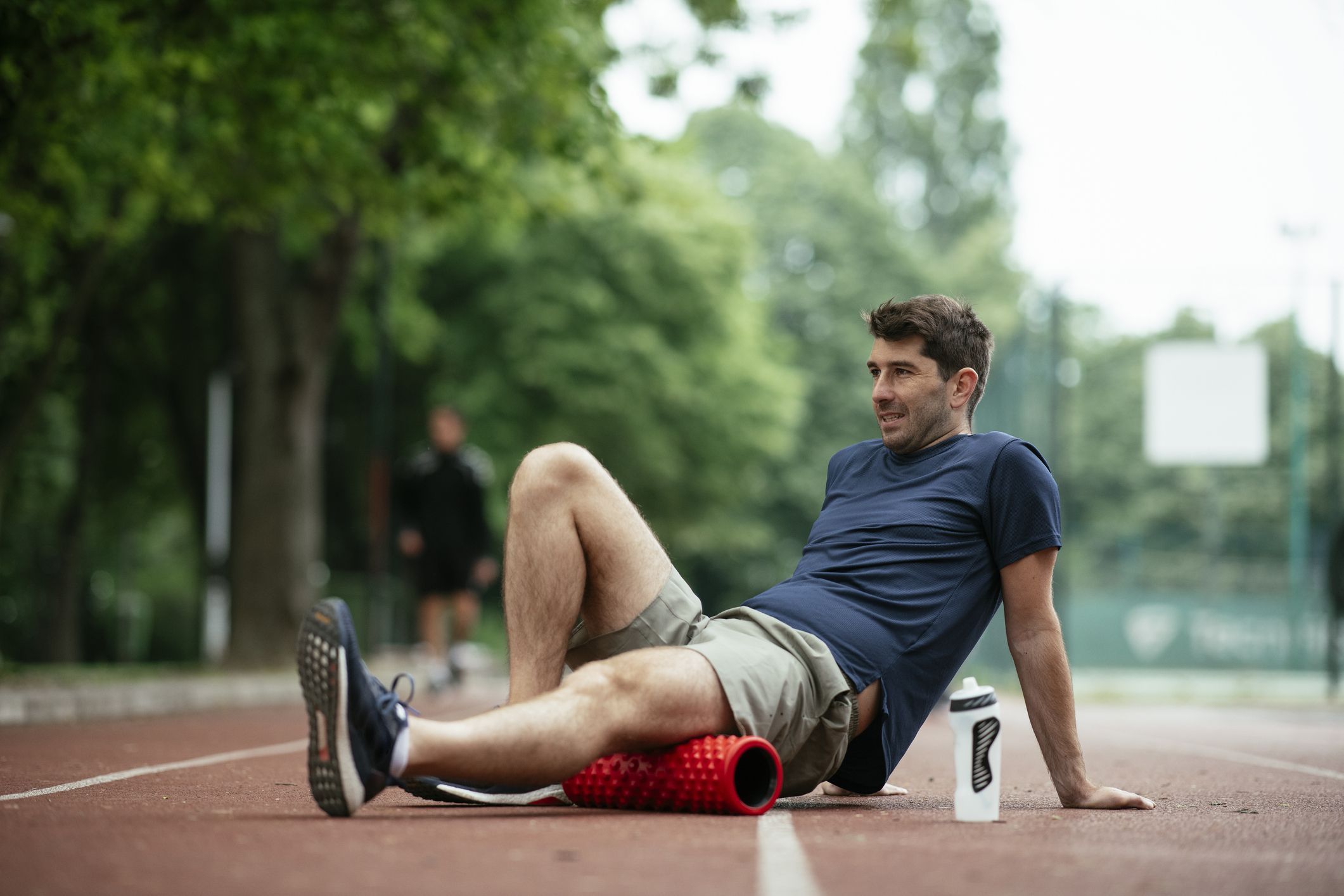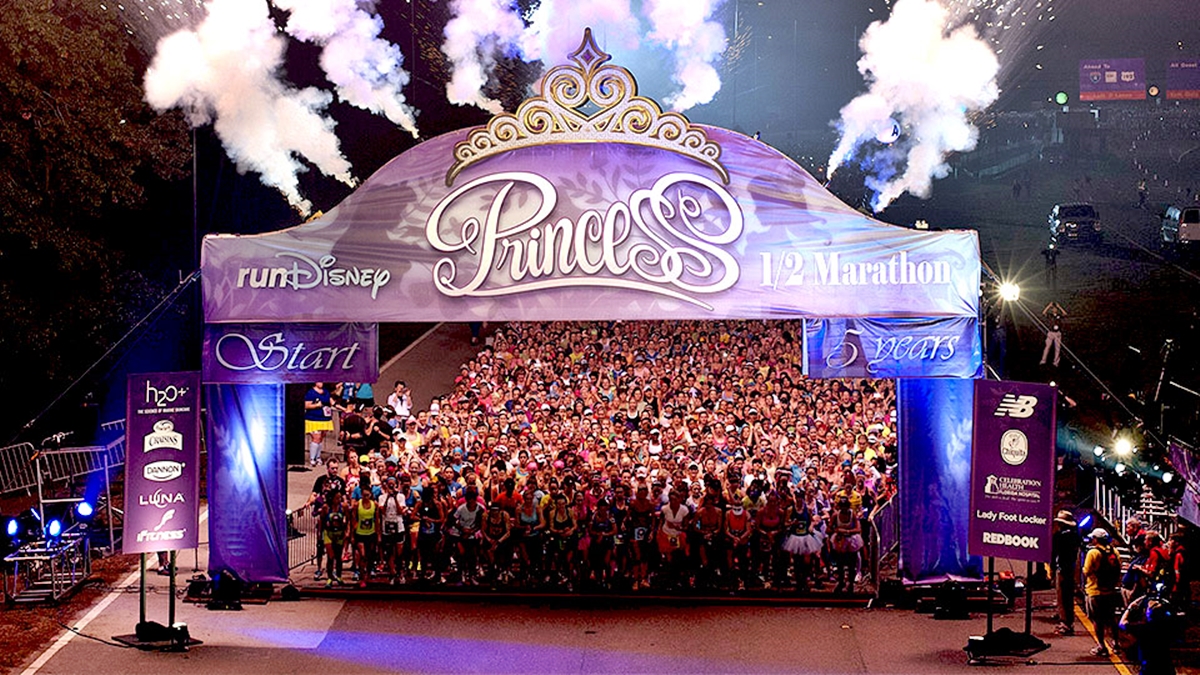Home>Misc>Featured>How To Train For Half Marathon In 4 Months


Featured
How To Train For Half Marathon In 4 Months
Modified: January 22, 2024
Learn how to train for a half marathon in just 4 months with our featured guide. Get expert tips and guidance to help you reach your running goals.
Introduction
Welcome to the exciting journey of training for a half marathon! Whether you’re a seasoned runner looking to tackle a new challenge or a beginner embarking on your first long-distance race, preparing properly is essential for a successful and enjoyable experience.
A half marathon, which covers a distance of 13.1 miles (21.1 kilometers), requires a combination of physical endurance, mental strength, and strategic training. In this article, we will guide you through the steps to train for a half marathon in just four months. While this timeframe may seem ambitious, with dedication and consistency, it’s possible to cross that finish line feeling strong and accomplished.
Before diving into the specifics of your training plan, it’s important to set realistic goals. What do you hope to achieve by completing this half marathon? Are you aiming to beat a personal record, simply finish the race, or raise money for a charitable cause? Defining your goals will provide you with the motivation and focus needed to stay committed throughout your training journey.
Once you’ve established clear objectives, it’s time to create a training plan. This plan will serve as your roadmap, outlining the workouts, mileage, and rest days needed to progress effectively. Whether you choose to follow a pre-designed plan or work with a running coach, make sure it aligns with your current fitness level and the time available for training.
Building endurance is a crucial aspect of half marathon training. Gradually increasing your mileage over the course of the training period will allow your body to adapt to the demands of longer distances. Incorporating longer runs into your weekly routine, such as a weekly long run, will progressively prepare you for the race day.
While endurance is important, it’s equally necessary to incorporate speed work into your training. Interval training, tempo runs, and hill repeats will enhance your cardiovascular capacity and improve overall running performance. These workouts should be gradually introduced and performed once or twice a week, alongside your regular training runs.
In the upcoming sections, we will delve into the various elements of half marathon training, including increasing mileage, rest and recovery, nutrition and hydration, cross-training, injury prevention, and mental preparation. By the end of this article, you’ll be equipped with the knowledge and tools necessary to embark on your four-month training journey.
Setting Goals
Before you lace up your running shoes and hit the pavement, take some time to set clear and realistic goals for your half marathon journey. Setting goals will give you direction and motivation throughout the training process, helping you stay focused and committed. Here are some steps to help you establish meaningful goals for your upcoming race:
- Reflect on your motivations: Think about why you want to take on a half marathon. Is it to challenge yourself, improve your fitness, or achieve a personal milestone? Understanding your motivations will help you set goals that align with your aspirations.
- Consider your current fitness level: Take an honest assessment of your current fitness level. Evaluate your running experience, recent race times, and overall physical condition. This will give you a starting point from which to set goals that are challenging yet attainable.
- Set specific and measurable goals: It’s important to make your goals specific and measurable. Instead of saying, “I want to finish the race,” consider setting a time goal like, “I want to complete the half marathon in under two hours.” This provides a clear target to work towards and allows you to track your progress more effectively.
- Make your goals realistic: While it’s great to aim high, it’s also important to ensure your goals are attainable. Setting unrealistic expectations can lead to frustration and disappointment. Consider factors such as your current fitness level, available training time, and any potential limitations or commitments you may have.
- Break down your goals: Breaking down your main goal into smaller, more manageable milestones can help keep you motivated and give you a sense of progress along the way. This can include achieving specific distances or training paces leading up to the race.
- Write down your goals: Putting your goals down on paper (or typing them out) increases their significance and helps solidify your commitment. Keep your goals visible, whether it’s on your fridge, your phone’s notes app, or a poster on your wall. Visual reminders can help you stay focused and motivated when the going gets tough.
- Be flexible and adapt: It’s important to remember that setting goals doesn’t mean rigidly adhering to them without any room for adjustments. Life happens, and circumstances may change. Be flexible and willing to adapt your goals as needed, while still maintaining an overall sense of purpose.
By taking the time to set meaningful and realistic goals for your half marathon, you’ll have a clear sense of direction throughout your training journey. Your goals will serve as a constant reminder of what you’re working towards, keeping you motivated and determined to succeed. So, grab a pen and paper, and start mapping out your goals for this exciting challenge!
Creating a Training Plan
Now that you have established your goals, it’s time to create a training plan that will help you achieve them. A well-structured training plan is key to ensuring a gradual and sustainable progression towards your half marathon. Here’s a step-by-step guide to creating an effective training plan:
- Evaluate your current fitness level: Assess your current running ability, including your average pace, longest distance run, and recent race performances. This will give you a starting point to gauge your current fitness and plan your training accordingly.
- Set a realistic time frame: Determine how many weeks or months you have until race day. Ideally, a training plan for a half marathon should span at least 12-16 weeks, giving you enough time to build endurance and improve your running performance.
- Choose a training method: There are various training approaches you can adopt, such as the traditional long run-focused method or a more advanced approach that incorporates intervals, tempo runs, and cross-training. Consider your goals, fitness level, and personal preferences when selecting a training method.
- Design your weekly schedule: Divide your training plan into weeks and sketch out a schedule that includes a balance of different types of runs. Assign specific days for your long runs, speed workouts, easy runs, and rest days. Make sure to include at least one or two days of rest each week to allow for recovery.
- Increase mileage gradually: Gradually increase your weekly mileage to build endurance and avoid overtraining or injury. Aim to increase your mileage by no more than 10% each week. Prioritize gradual progression over rapid mileage jumps.
- Plan for cross-training: Incorporate cross-training activities (such as cycling, swimming, or strength training) into your schedule. These activities help improve overall fitness, strengthen different muscle groups, and reduce the risk of running-related injuries.
- Listen to your body: Pay attention to how your body responds to the training. If you experience persistent pain or excessive fatigue, modify your training plan accordingly. It’s crucial to strike a balance between pushing your limits and allowing for adequate rest and recovery.
- Track your progress: Keep a training log to record your runs, distances, times, and how you feel during and after each workout. This will help you track your progress over time and make any necessary adjustments to your training plan.
- Adapt as needed: Stay flexible and adjust your training plan as necessary. Life happens, and unexpected circumstances may arise that require modifications to your schedule. Don’t be afraid to make changes to accommodate for any challenges that come your way.
Creating a well-structured training plan is essential to your success in completing a half marathon. Consider your current fitness level, available time, and preferred training methods when designing your plan. Remember to gradually increase your mileage, incorporate cross-training, and listen to your body’s signals. With a solid training plan in place, you’ll be on your way to achieving your goals and crossing that finish line with confidence!
Building Endurance
Building endurance is a critical component of your half marathon training. It allows your body to adapt to the demands of running longer distances and ensures that you’re able to sustain your pace throughout the race. Here are some strategies to help you gradually build your endurance:
- Start with a solid base: Before diving into intense training, ensure that you have a good running foundation. This means being able to comfortably run a few miles without feeling overly fatigued. If necessary, spend a few weeks focusing on shorter, easy runs to build your base mileage.
- Increase mileage gradually: Gradual progression is key when it comes to building endurance. Aim to increase your weekly mileage by no more than 10% to avoid overtraining and reduce the risk of injuries. Gradually adding more miles to your weekly long run is an effective way to build endurance.
- Integrate cross-training: Cross-training activities can help improve your cardiovascular fitness and strengthen different muscle groups. Consider incorporating activities such as swimming, cycling, or elliptical training into your routine. These low-impact exercises provide a break from running while still maintaining your fitness level.
- Include a weekly long run: Consistently performing a long run each week is crucial for building endurance. Start with a distance that feels challenging but achievable, and gradually increase it each week. Aim to increase your long run distance by no more than 1-2 miles per week.
- Go for time on your feet: Instead of solely focusing on distance, consider incorporating time-based runs into your training. This means running for a specific duration rather than a set distance. This approach helps build endurance by getting your body accustomed to being on your feet for extended periods.
- Practice negative splits: Negative splits involve running the second half of your run or race faster than the first half. This pacing strategy helps build stamina and teaches your body to maintain a consistent effort over longer distances. During your long runs, aim to finish the second half slightly faster than the first.
- Take advantage of rest days: Rest days are just as important as training days. They give your body time to recover and rebuild, helping to improve endurance in the long run. Use rest days to prioritize restorative activities such as gentle stretching, foam rolling, or yoga.
- Focus on form and breathing: Proper running form and efficient breathing techniques can help conserve energy and improve endurance. Pay attention to your posture, stride length, and foot strike. Practice deep belly breathing to maximize oxygen intake and reduce fatigue.
- Stay consistent: Building endurance takes time and consistency. Aim to run at least three to four times per week, adhering to your training plan. Consistency allows your body to adapt gradually and build the necessary stamina for race day.
Building endurance is a gradual process that requires consistency, patience, and a balanced training approach. By gradually increasing your mileage, incorporating cross-training, and focusing on proper form and breathing, you’ll develop the necessary endurance to conquer your half marathon goal. Remember, building endurance is a journey, so trust the process and enjoy the progress along the way!
Incorporating Speed Work
Incorporating speed work into your training regimen is crucial for improving your running performance and enhancing your overall speed and stamina. Speed workouts involve running at faster paces for short durations, challenging your body to adapt to higher intensities. Here are some tips for effectively incorporating speed work into your half marathon training:
- Start gradually: If you’re new to speed work, it’s important to ease into it. Start with short intervals at a comfortably challenging pace. As your fitness improves, you can gradually increase the duration and intensity of these intervals.
- Types of speed workouts: There are several types of speed workouts you can incorporate into your training. These include interval training, tempo runs, and hill repeats. Interval training involves alternating between periods of fast running and recovery periods. Tempo runs involve sustained efforts at a comfortably hard pace. Hill repeats involve running up and down hills to build both strength and speed.
- Interval training: One popular method of interval training for half marathon runners is the 4×400-meter workout. This involves running four sets of 400-meter intervals at a fast pace, with a short recovery period in between. As you progress, you can increase the number of intervals or the distance of each interval.
- Tempo runs: Tempo runs are longer sustained efforts at a comfortably hard pace. Aim to maintain a pace that feels challenging but sustainable for a longer period. Start with a shorter tempo run, such as 2-3 miles, and gradually build up to longer distances as your fitness improves.
- Hill repeats: Hill repeats are an excellent way to build both strength and speed. Find a moderate hill and run up it at a fast pace, focusing on pumping your arms and maintaining good form. Jog back down the hill to recover, and repeat the process for a set number of repetitions.
- Rest and recovery: Speed workouts can place additional stress on your body, so it’s important to incorporate adequate rest and recovery days into your training plan. Allow yourself enough time to recover between intense speed sessions to prevent overtraining and reduce the risk of injury.
- Consistency is key: To see improvements in your speed and endurance, consistency is crucial. Aim to incorporate speed workouts into your training plan at least once or twice a week. Consistent training helps your body adapt to higher intensities and improves your overall running performance.
- Monitor your progress: Keep track of your speed workout times and paces to monitor your progress over time. This will help you track improvements and adjust your training plan as needed.
- Warm-up and cool-down: Before each speed workout, make sure to warm up with dynamic stretches and a light jog to prepare your muscles for the intensity. After the workout, cool down with an easy jog and static stretches to promote recovery.
Incorporating speed work into your half marathon training will not only improve your overall running performance but also increase your race day confidence. Add variety to your training by including interval training, tempo runs, and hill repeats. Remember to prioritize rest and recovery and track your progress along the way. With consistent speed work, you’ll be on your way to achieving new personal records and pushing your limits in the half marathon.
Increasing Mileage
As you prepare for a half marathon, gradually increasing your running mileage is essential. Increasing your mileage helps build endurance, improves your aerobic capacity, and prepares your body to handle the demands of the race. Here are some tips to help you effectively increase your mileage:
- Set realistic goals: Determine how much you want to increase your mileage over a set period of time. It’s important to set goals that are achievable and align with your current fitness level and running experience.
- Follow the 10% rule: To avoid overuse injuries, a general guideline is to increase your weekly mileage by no more than 10%. This ensures a gradual and manageable progression.
- Focus on the long run: The long run is a key component of your training. Each week, aim to complete a long run that gradually increases in distance. Start with a distance that feels challenging but comfortable and add a mile or two each week.
- Incorporate shorter runs: In addition to the long run, include shorter runs throughout the week. These runs help to reinforce endurance while allowing for recovery. Vary the pace and distance of your shorter runs to keep your training interesting.
- Plan for step-back weeks: Every few weeks, schedule a step-back week where you reduce your mileage to allow for recovery and prevent burnout. This break in mileage will help you maintain freshness and prevent overtraining.
- Listen to your body: Pay attention to how your body feels and adapt your mileage accordingly. If you experience excessive fatigue, persistent soreness, or recurring injuries, it may be necessary to decrease your mileage temporarily.
- Quality over quantity: It’s not just about the number of miles you run, but the quality of those miles. Focus on the quality of your runs by incorporating speed work, hill repeats, and tempo runs. These workouts help improve running efficiency and overall performance.
- Gradually increase midweek mileage: Alongside increasing your long run distance, gradually increase the distance of your midweek runs to build overall mileage. This will help further develop your endurance.
- Consider cross-training: Incorporating cross-training activities such as cycling, swimming, or strength training can help build cardiovascular fitness and reduce the risk of overuse injuries. Include these activities on your non-running days to supplement your training.
- Stay consistent: Consistency is key when it comes to increasing mileage. Stick to your training plan, even on days when motivation may be low. Consistent training helps your body adapt and progress steadily towards your goals.
Increasing your mileage for a half marathon is a gradual process that requires patience and consistency. Follow the 10% rule, focus on the long run, and include shorter runs and cross-training activities. Listen to your body, practice quality over quantity, and stay consistent with your training. With each gradual increase in mileage, you’ll be one step closer to crossing the finish line of your half marathon with confidence.
Rest and Recovery
Rest and recovery are often overlooked aspects of training, but they are crucial for your overall performance and injury prevention. Proper rest and recovery allow your body to repair and adapt to the stress of training, ultimately leading to improved performance. Here are some tips for incorporating rest and recovery into your half marathon training:
- Schedule regular rest days: Rest days are just as important as training days. Plan for at least one or two rest days per week to allow your body to recover and recharge. Use these days for light activities, gentle stretching, or relaxation techniques.
- Listen to your body: Pay attention to how your body feels on a daily basis. If you’re feeling excessively fatigued, experiencing persistent soreness, or noticing any warning signs of injury, it’s important to prioritize rest and recovery. Pushing through pain or excessive fatigue can lead to overuse injuries and hinder progress.
- Incorporate active recovery: On your rest days, consider incorporating active recovery activities that promote blood flow and muscle relaxation. These can include walking, gentle yoga, foam rolling, or using a massage ball to target specific areas of tightness or discomfort.
- Get enough sleep: Sleep is essential for muscle repair, hormone regulation, and overall recovery. Aim for seven to nine hours of quality sleep each night to support your training efforts. Establish a consistent sleep routine and create a sleep-friendly environment to optimize your rest.
- Hydrate and refuel properly: Proper hydration and nutrition are key components of rest and recovery. Drink plenty of water throughout the day to stay hydrated and replenish electrolytes lost through sweat. Refuel with a balanced diet that includes carbohydrates, protein, and healthy fats to aid in muscle repair and glycogen replenishment.
- Incorporate easy runs and recovery workouts: On your training days, consider incorporating easy runs or recovery workouts. These light workouts help promote active recovery by increasing blood flow to the muscles without placing excessive stress on the body.
- Use restorative techniques: In addition to active recovery, utilize restorative techniques such as stretching, foam rolling, and mobility exercises. These activities promote flexibility, reduce muscle tension, and improve overall mobility, enhancing your recovery process.
- Manage stress levels: Chronic stress can hinder your body’s ability to recover effectively. Incorporate stress management techniques such as deep breathing exercises, meditation, or mindfulness practices into your routine. Taking time to relax and de-stress is vital for both physical and mental recovery.
- Consider regular sports massages: Sports massages can help relieve muscle tension, improve circulation, and enhance muscle recovery. Consider incorporating regular massages into your training plan, especially during periods of increased intensity or leading up to the race.
- Be flexible with your training schedule: Sometimes life happens, and circumstances may require adjustments to your training plan. Be flexible and willing to adapt your schedule when needed to prioritize rest and recovery. Your long-term progress is more important than sticking rigidly to a plan.
Rest and recovery are essential components of half marathon training. Prioritize regular rest days, listen to your body, and incorporate active recovery activities. Focus on quality sleep, proper hydration, and nutrition. Utilize restorative techniques and manage stress levels effectively. By incorporating these practices into your training routine, you’ll optimize your overall performance, prevent burnout, and reduce the risk of injuries.
Nutrition and Hydration
Nutrition and hydration play a crucial role in your half marathon training. Proper fueling and hydration not only provide the energy you need for training runs, but also contribute to your overall performance, recovery, and overall well-being. Here are some key tips for optimizing your nutrition and hydration during your training:
- Focus on balanced meals: Build your diet around whole, nutrient-dense foods that provide a balance of carbohydrates, protein, and healthy fats. Include a variety of fruits, vegetables, whole grains, lean proteins, and healthy fats in your meals to ensure you’re getting the essential nutrients your body needs.
- Prioritize carbohydrates: Carbohydrates are the primary fuel source for endurance activities like running. Include complex carbohydrates, such as whole grains, legumes, fruits, and vegetables, in your diet to provide sustained energy. Aim to consume a mix of carbohydrates throughout the day, including before and after your runs.
- Adequate protein intake: Protein is crucial for muscle repair and recovery. Include lean protein sources such as chicken, fish, tofu, beans, and dairy products in your meals to support muscle growth and repair. Aim for a balance of protein with each meal and snack.
- Stay hydrated: Proper hydration is essential for optimal performance. Aim to drink enough water throughout the day to stay properly hydrated. During your runs, hydrate with water or sports drinks based on your individual needs and preferences. Take into account factors like weather conditions and the duration of your run.
- Pre-run fueling: Eat a pre-run meal that is rich in carbohydrates and moderate in protein and fat to provide the necessary energy for your training. Choose easily digestible foods such as oatmeal, bananas, or whole wheat toast. Experiment with different foods to find what works best for you.
- Fuel during long runs: During longer runs, especially those lasting more than an hour, it’s important to consume carbohydrates to maintain energy levels. Experiment with different forms of fuel, such as energy gels, chews, or sports drinks, to find what suits your stomach and provides the necessary energy for your runs.
- Recovery nutrition: After your runs, focus on replenishing your energy stores and aiding muscle recovery. Consume a combination of carbohydrates and protein within 30-60 minutes after your run to enhance recovery. Good options include a protein shake, a fruit smoothie with added protein, or a balanced meal containing lean protein and carbohydrates.
- Listen to your body: Pay attention to how different foods and hydration strategies affect your energy levels, digestion, and performance. Everyone’s nutritional needs are unique, so it’s important to listen to your body and make adjustments accordingly. Keep a food and hydration journal to track what works best for you.
- Avoid excessive alcohol and caffeine: While it’s okay to enjoy these beverages in moderation, excessive alcohol and caffeine intake can negatively impact hydration levels and affect your sleep quality. Opt for water, herbal tea, and electrolyte-rich drinks as your primary hydration choices.
- Consult a professional: If you have specific dietary concerns or questions, consider consulting a registered dietitian or sports nutritionist. They can provide personalized advice based on your individual needs and goals.
Proper nutrition and hydration are vital for your half marathon training success. Focus on balanced meals, prioritize carbohydrates, and include adequate protein. Stay hydrated by drinking enough water throughout the day and adjusting your intake based on your training needs. Experiment with pre-run fueling and fueling strategies during long runs. Listen to your body, make adjustments based on your individual needs, and consider consulting a professional for personalized guidance. With proper nutrition and hydration, you’ll enhance your performance, support recovery, and optimize your training efforts.
Cross-Training
Cross-training is an essential component of a well-rounded half marathon training plan. It involves participating in activities other than running to supplement your training, improve overall fitness, and prevent overuse injuries. Here are some key benefits and tips for incorporating cross-training into your half marathon training:
- Injury prevention: Engaging in cross-training activities helps reduce the risk of overuse injuries by giving your running muscles a break from repetitive impact. It allows you to work other muscle groups, improve strength, and build overall fitness, creating a more balanced and resilient body.
- Improved cardiovascular fitness: Cross-training activities such as swimming, cycling, or aerobics help improve cardiovascular fitness without the impact stress of running. These activities increase your aerobic capacity, allowing you to maintain a higher level of endurance during your runs.
- Muscular balance and strength: Incorporating strength training into your cross-training routine helps build muscular strength and balance. Focus on exercises that target key running muscles, such as your core, glutes, hip flexors, and leg muscles. Developing these muscles can enhance your running efficiency and reduce the risk of imbalances or weaknesses that may lead to injuries.
- Active recovery: Cross-training can be a form of active recovery on your rest days or light training days. Engaging in activities such as yoga, Pilates, or gentle stretching routines helps improve flexibility, reduce muscle soreness, and promote overall recovery.
- Varied training stimulus: Doing the same activity over and over again can lead to boredom and mental burnout. Cross-training provides a variety of activities that can make your training more enjoyable and mentally stimulating. Mixing up your workouts keeps things fresh and helps you stay motivated throughout your training journey.
- Incorporate low-impact activities: Activities like swimming, aqua jogging, and cycling are low-impact options that reduce the stress on your joints while still providing an excellent cardiovascular workout. These activities can be particularly beneficial during injury recovery or when you need to give your body a break from high-impact running.
- Find activities you enjoy: Choose cross-training activities that you genuinely enjoy. It could be anything from dancing, hiking, or team sports to yoga, Pilates, or kickboxing. When you enjoy the activity, you’re more likely to stick with it and reap the benefits.
- Plan your cross-training sessions: Incorporate cross-training into your weekly schedule alongside your running workouts. Aim for two to three cross-training sessions per week, focusing on different activities to work different muscle groups and provide variety.
- Listen to your body: Monitor how your body responds to cross-training activities. If you experience pain or discomfort during a particular activity, modify or substitute it with a more suitable option. The goal is to complement your running training, not compromise it.
- Balance with rest and recovery: While cross-training is beneficial, it’s important to strike a balance and not overdo it. Allow yourself enough time for rest and recovery between cross-training sessions and running workouts. Prioritize quality sleep, proper nutrition, and adequate hydration to support your body’s recovery.
Cross-training is a valuable tool to enhance your half marathon training. By incorporating a variety of activities into your routine, you can improve overall fitness, prevent injuries, and ward off boredom. Find activities you enjoy, listen to your body, and strike a balance between cross-training and rest. With a well-rounded training approach, you’ll be on your way to achieving your half marathon goals with strength and resilience.
Injury Prevention
Injury prevention is a crucial aspect of your half marathon training. Sustaining an injury can set back your progress and potentially sideline you from training altogether. To ensure a safe and successful training journey, here are some essential tips for preventing injuries:
- Build a strong foundation: Begin your training with a solid foundation of strength and mobility. Incorporate regular strength training exercises that target key running muscles, such as your core, glutes, hips, and legs. Strengthening these areas helps support your body while running and reduces the risk of imbalances that can lead to injuries.
- Gradual progression: Gradually increase your mileage and training intensity to allow your body time to adapt. Avoid sudden spikes in mileage or intensity, as this can lead to overuse injuries. Adhere to the 10% rule, which recommends increasing your mileage by no more than 10% per week.
- Listen to your body: Pay attention to any signs of pain, discomfort, or unusual fatigue. If you experience persistent pain, swelling, or a change in your running gait, it’s important to address it promptly. Rest, seek medical attention if needed, and don’t ignore warning signs that something may be off.
- Wear proper footwear: Invest in a good pair of running shoes that provide the cushioning and support that your feet and legs need. Get fitted properly at a running specialty store, considering factors such as your foot type, gait, and running form. Replace your shoes regularly to ensure they continue to provide adequate support.
- Warm up and cool down: Warm up before each run with dynamic stretches and light jogging to prepare your muscles and joints for the upcoming activity. After your run, cool down with gentle stretches and foam rolling to promote muscle recovery and reduce muscle tightness.
- Listen to your body’s need for rest: Rest and recovery days are crucial for allowing your body time to repair and rebuild. Incorporate rest days into your training schedule and include low-intensity cross-training or active recovery exercises on those days. Adequate rest helps prevent overuse injuries and allows your body to adapt and become stronger.
- Follow a well-rounded training plan: A well-designed training plan encompasses a variety of workouts, including easy runs, speed work, long runs, and cross-training. This balance helps prevent repetitive strain injuries and allows for adequate recovery between intense training sessions.
- Include flexibility, mobility, and balance exercises: Incorporate stretching, foam rolling, yoga, Pilates, or other flexibility and mobility exercises into your routine. These activities improve joint range of motion, reduce muscle imbalances, and enhance overall body alignment, reducing the risk of injuries.
- Address biomechanical issues: If you notice chronic pain or recurring injuries, consider seeing a physical therapist or sports medicine professional. They can assess your running form, biomechanics, and identify any underlying issues that may contribute to the risk of injury. Correcting these issues can help prevent future injuries.
- Proper nutrition and hydration: A balanced diet and proper hydration are essential for recovery and injury prevention. Ensure you’re consuming adequate nutrients to support your training and repair of muscle tissues. Stay hydrated before, during, and after workouts to maintain optimal performance and promote tissue health.
By following these injury prevention tips, you can minimize the risk of setbacks during your half marathon training. Build strength, listen to your body, take rest days when needed, wear proper footwear, and incorporate flexibility exercises. Remember that injury prevention is an ongoing process, so be mindful and proactive in caring for your body throughout your training journey.
Mental Preparation
Mental preparation is just as important as physical training when it comes to completing a half marathon. Running long distances requires mental strength, focus, and resilience. By implementing these mental preparation strategies, you can boost your confidence, stay motivated, and overcome challenges on race day:
- Set positive and realistic expectations: Visualize yourself crossing the finish line and achieving your goals. Set realistic expectations for your performance, considering factors such as your current fitness level and previous race experiences. Maintaining a positive mindset helps cultivate confidence and keeps you motivated throughout your training.
- Practice mental imagery: Visualize yourself successfully completing the race. Imagine yourself running with ease, feeling strong and confident. This mental rehearsal primes your mind for success and helps reduce pre-race anxiety.
- Embrace the discomfort: Long-distance running can be physically and mentally challenging. Accept that there will be moments of discomfort and difficulty during training and on race day. Embrace the discomfort, knowing that it is a natural part of the process, and focus on your determination to push through it.
- Practice positive self-talk: Monitor your inner dialogue and replace negative thoughts with positive affirmations. Encourage yourself with motivating phrases such as, “I am strong,” “I can do this,” and “I am capable of reaching my goals.” Positive self-talk helps boost confidence and keeps you mentally resilient during tough moments.
- Break the race into smaller milestones: Dividing the race into smaller, more manageable milestones can make it feel less overwhelming. Focus on reaching one mile marker at a time or breaking the race into smaller time intervals. This strategy helps maintain focus and gives you a sense of progress throughout the race.
- Practice mindfulness and staying present: Stay focused on the present moment during your training runs and on race day. Pay attention to your breathing, your stride, and the scenery around you. Engaging in mindfulness techniques can help reduce anxiety and keep your mind focused and calm.
- Create a race day plan: Set clear and achievable goals for the race. Break down your plan into specific strategies such as pacing, fueling, and hydration. Having a solid race day plan helps reduce pre-race jitters and provides structure and focus during the event.
- Develop coping strategies: Identify strategies that help you cope with challenging moments during your training and on race day. This can include using mantra repetition, focusing on your breathing, or imagining yourself crossing the finish line. Having coping strategies ready allows you to quickly shift your mindset and overcome obstacles.
- Stay connected to your “why”: Reflect on your motivation for participating in a half marathon. Whether it’s for personal growth, to support a cause, or to prove to yourself what you’re capable of, staying connected to your “why” helps maintain your motivation and determination, especially during challenging moments.
- Celebrate your progress and achievements: Recognize and celebrate the milestones and achievements throughout your training. This can be as simple as acknowledging a new personal best time or completing a challenging training run. Celebrating your progress helps reinforce your confidence and overall enjoyment of the journey.
Mental preparation is a powerful tool that can enhance your half marathon experience. Practice positive self-talk, visualize success, and embrace the discomfort. Break the race into smaller milestones, create a race day plan, and develop coping strategies. Stay connected to your motivation and celebrate your progress. With mental fortitude and resilience, you’ll be ready to conquer the challenges that come with a half marathon and cross that finish line with a sense of accomplishment.
Race Day Tips
Race day is the culmination of your hard work and training. It’s an opportunity to put your training to the test and achieve your goals. To make the most of your race day experience, consider these tips to help you prepare and perform your best:
- Create a pre-race routine: Establish a pre-race routine that includes familiar rituals and activities. This can include a light warm-up, stretching, hydrating, and eating a balanced meal a few hours before the race. Stick to what has worked during your training to ensure consistency and reduce pre-race nerves.
- Arrive early: Plan to arrive at the race venue early to avoid any last-minute stress. Familiarize yourself with the racecourse, locate the start and finish areas, and find the necessary facilities. Give yourself plenty of time to collect your bib, use the restroom, and mentally prepare for the race.
- Dress appropriately: Dress in comfortable, moisture-wicking clothing and wear your tried and tested running shoes. Consider the weather conditions and dress in layers if necessary. Avoid trying anything new on race day, including new gear or clothing, to prevent any unexpected discomfort or issues.
- Stick to your race plan: Follow the race day plan you created during your training. Stick to your desired pace, fueling strategy, and hydration plan. Trust in your training and avoid trying to go faster than planned in the early stages of the race.
- Maintain a steady pace: Start the race conservatively and gradually increase your pace as you become more comfortable. Avoid going out too fast in the beginning, as this can lead to early fatigue and difficulty maintaining your pace later on.
- Stay mentally focused: Throughout the race, stay mentally focused and maintain a positive mindset. Use positive self-talk, focus on your breathing, and remind yourself of your training and preparation. Embrace any challenging moments as opportunities to showcase your mental strength.
- Utilize aid stations strategically: Take advantage of the aid stations along the racecourse for hydration and fuel. Plan ahead for when and how often you’ll take fluids and energy gels or snacks. Familiarize yourself with the layout of the aid stations and hydrate according to your race day plan.
- Engage with the crowd: Draw energy from the cheering spectators and supporters along the race route. Interact with the crowd through smiles, high-fives, or acknowledging their encouragement. Their support can significantly boost your motivation and morale during the race.
- Stay hydrated and fueled: Take sips of water or sports drinks at every aid station to stay hydrated. If you have practiced using energy gels or other fueling methods during training, continue to use them as planned throughout the race to maintain your energy levels.
- Stay aware and adjust if needed: Continually assess how you’re feeling during the race and be prepared to adjust your pace or strategy if necessary. If you’re feeling particularly fatigued, consider taking short walking breaks or adjusting your goal time. Above all, listen to your body and prioritize your well-being.
- Celebrate at the finish line: As you near the finish line, summon your remaining energy and sprint across with a sense of accomplishment. Cherish the moment as you cross the finish line, and take a moment to celebrate your hard work, dedication, and the achievement of completing a half marathon.
Race day is the culmination of your training and the opportunity to showcase your preparation. By following these tips, you can set yourself up for success and have an enjoyable race experience. Stick to your race plan, maintain a positive mindset, and remember to celebrate your accomplishment. Most importantly, have fun and savor every moment of your half marathon journey!
Conclusion
Congratulations! You have reached the end of this comprehensive guide on how to train for a half marathon in just four months. Throughout this article, we’ve covered various aspects of training, including goal setting, creating a training plan, building endurance, incorporating speed work, increasing mileage, rest and recovery, nutrition and hydration, cross-training, injury prevention, mental preparation, and race day tips.
Training for a half marathon is a challenging yet rewarding journey that requires dedication, consistency, and perseverance. By setting realistic goals, following a well-structured training plan, and listening to your body, you can progressively build your endurance, strengthen your body, and improve your running performance.
In addition to physical training, don’t underestimate the power of mental preparation. Cultivating a positive mindset, practicing visualization, and staying mentally focused will help you navigate through tough moments during training and on race day.
Remember to prioritize rest and recovery, fuel your body with proper nutrition, and stay hydrated throughout your training. Incorporating cross-training activities into your routine and taking steps to prevent injuries will also contribute to a successful training cycle.
Finally, on race day, arrive prepared and confident. Stick to your race plan, keep a steady pace, engage with the crowd, and adjust as needed. Celebrate your achievements as you cross the finish line and reflect on the progress you’ve made throughout your training journey.
Now, lace up your running shoes, embrace the challenge, and embark on your half marathon training adventure. Trust the process, believe in yourself, and enjoy the fulfilling experience of crossing the finish line of your half marathon with a sense of accomplishment. Good luck!









